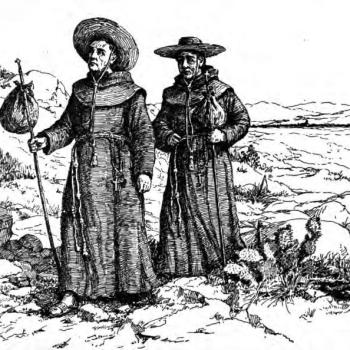My new book Crucible of Faith is out tomorrow, September 19. I summarized the main arguments in an earlier post, but let me here present the opening section.
According to Matthew’s Gospel, Jesus told the frightening parable of the Wheat and the Tares. This tells of a man sowing good seed in a field. In the night, an enemy sows tares (weeds) among the wheat, and the two kinds of plant grow up together. The farmer tells his servants not to try purging the tares right now, or they will certainly damage the wheat in the process. “Let both grow together until the harvest. At that time I will tell the harvesters: First collect the weeds and tie them in bundles to be burned; then gather the wheat and bring it into my barn.” Jesus explains his meaning:
The one who sowed the good seed is the Son of Man. The field is the world, and the good seed stands for the people of the kingdom. The weeds are the people of the evil one, and the enemy who sows them is the devil [diabolos]. The harvest is the end of the age, and the harvesters are angels…. The Son of Man will send out his angels, and they will weed out of his kingdom everything that causes sin and all who do evil. They will throw them into the blazing furnace, where there will be weeping and gnashing of teeth. Then the righteous will shine like the sun in the kingdom of their Father.
As with so many such stories credited to him, Jesus used commonplace rural imagery, but framed in a world-view that made many assumptions about spiritual realities, about the universe and its hierarchies. Among the themes offered, we find a forthcoming Day of Judgment, which is marked by apocalyptic fires. We read that God has a powerful adversary called the Devil, but he also mobilizes legions of loyal spiritual beings called angels. Depending on how we understand the passage, God exercises his earthly rule through the Son of Man, a messianic figure. Forces of good and evil, light and darkness, contend in the world until God’s final victory. People must be urgently concerned about these conflicts because their conduct in the present world will affect their fate in the afterlife. Heaven and Hell are ultimate realities.
Although this parable is unusually explicit in its hellfire imagery, the basic ideas are quite unsurprising to anyone who knows the West’s religious heritage. Angels and Judgment, Messiah and Satan, Hell and demons, cosmic warfare and a fallen world…. all are so obvious as to be totally unsurprising. What virtually no modern reader will understand from such a passage is just how radically new the themes and ideas were in historical terms at the time Jesus spoke.
In no sense was Jesus “telling the old, old story” from the Bible as he knew it, namely the Hebrew Bible or Old Testament. Nor, though, was he proclaiming a new cosmic framework that he had invented, or was revealing afresh. Rather, he was presenting a thoroughly new story, which had emerged over the two or three centuries before his time, but which had become so thoroughly integrated and acclimatized into Jewish religious thought as to seem inevitable.
A revolution is a transformation so fundamental that it is impossible for anyone living after that change to imagine what conditions were like beforehand. Between about 250 BC and 50 BC, the Jewish world experienced a far-reaching spiritual revolution that in effect created the religious assumptions on which the Western world has been based ever since. So familiar have those assumptions become, in fact, that it seems incredible to us to imagine an alternative, or to think back to a time when these did not exist. Hence, we wrongly tend to back-project those ideas into the older world, and into the Hebrew Bible itself.
In Jesus’s time, the Pharisees and Sadducees were two of the great religious/political parties contesting for the control of the Jewish world. As the Book of Acts notes, “The Sadducees say that there is no Resurrection, and that there are neither angels nor spirits, but the Pharisees believe all these things” (Acts 23.8). Christian writers long debated how the Sadducees could have formed their seemingly skeptical and materialist opinions, but in fact they were just following the older Jewish world-view described in the Hebrew Bible, or Old Testament. It was the Pharisees who were the radical modernizers, who had absorbed all the innovations that had grown up in the previous couple of centuries. The Sadducees were simply stubborn conservatives who refused to acknowledge the inconceivable theological changes under way during the Crucible years.
Those critical centuries, before the turn of the Common Era, made the religious world the West has known ever since. Without this transformation, neither Christianity nor Islam would exist, and Judaism itself would have been unimaginably different.
Such a radical transformation of religious thought in such a relatively brief period makes this one of the most revolutionary times in human thought. Yet the fact of that change, and the profundity of its character, is rarely acknowledged. In those centuries, the Jewish and Jewish-derived world was a fiery crucible of values, faiths and ideas, from which emerged wholly new religious syntheses. That era, and that transformation, is the subject of Crucible of Faith. Or as the subtitle reads, this was The Ancient Revolution That Made Our Modern Religious World.


















